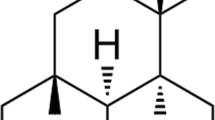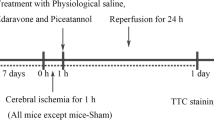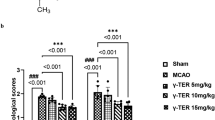Abstract
Backgrounds
Cerebral ischemia-reperfusion leads to brain tissue injury. Inflammation and apoptosis play pivotal roles in the pathology.
Objective
α-Pinene is an organic compound of many aromatic plants and is known as a potent agent to possess antioxidant, and anti-inflammatory properties. Here, we sought to identify the anti-inflammatory and anti-apoptosis mechanism by which α-Pinene improves brain ischemia injury.
Results
Male Wistar rats underwent MCAO surgery for 1 h and different doses of alpha-pinene (25, 50, and 100 mg/kg) were intraperitoneally injected immediately after reperfusion to test this hypothesis. IV, NDS, gene and protein expression of inducible nitric oxide synthase (iNOS), cyclogenase-2 (COX-2), nuclear factor kappa B (NF-κB) p65, and caspase-3 were assessed 24 h after reperfusion. Results demonstrated that NF-κB p65, iNOS, and COX-2 gene and protein expression increased in the hippocampus, cortex, and striatum after 24 h of reperfusion, and alpha-pinene significantly inhibited NF-kB p65, iNOS, and COX-2 expression. Also, alpha-pinene significantly reduced the ischemia/reperfusion-induced caspase-3 activation in CA1 area of hippocampus.
Conclusion
Results showed that alpha-pinene protects the cerebral against ischemic damage caused by MCAO, and this effect may be through the regulating iNOS -NF-kappa B- COX-2 and caspase-3 inflammatory and apoptotic pathways.
Graphical abstract







Similar content being viewed by others
References
Zhang DL, Liu X, Wang Q, Li N, Wu SH et al (2019) Downregulation of microRNA-196a attenuates ischemic brain injury in rats by directly targeting HMGA1. Eur Rev Med Pharmacol Sci 23:740–748
Yunfei Z, Xiaojing Z, Xinye C, Yun W (2022) Neuronal injuries in cerebral infarction and ischemic stroke:from mechanisms to treatment. Int J Mol Med 49:15
Reggie L, Michelle L, Celeste W, Alexandre S, Harlee P et al (2022) Cerebral ischemia and neurodegeneration. Neural Regen Res 13:373–385
Wei-Sen C, Hung-Chih H, Yi-Wen C, Meng L, Kuan-Yu L, Yi-Fei C et al (2020) Predictors for the use of traditional chinese medicine among inpatients with first-time stroke: a population-based study. BMC Complement Med Ther 20:244
Brandon J, Thompson, Patrick T (2014) Ronaldson, drug delivery to the ischemic brain. Adv Pharmacol 71:165–202
Emine Ş, Ihsan S, Yasemin G (2018) Cell death mechanisms in stroke and novel molecular and cellular treatment options. Curr Neuropharmacol 16:1396–1415
Zhao L, Willing A (2018) Enhancing endogenous capacity to repair a stroke-damaged brain: an evolving field for stroke research. Prog Neurobiol 5:163–164
Patel AR, Ritzel R, Mccullough LD, Fudong L (2013) Microglia and ischemic stroke: a double-edged sword. Int J Physiol Pathophysiol Pharmacol 5:73–90
Xiaoyan J, Anuska A, Ling Z, Tuo Y, Michael B, Jun C et al (2018) Blood-brain barrier dysfunction and recovery after ischemic stroke. Prog Neurobiol 163:144–171
Jun Rong L, Xian Kun T, Yang W, De Wen T, Song Sheng S (2019) Resveratrol downregulates the TLR4 signaling pathway to reduce brain damage in a rat model of focal cerebral ischemia. Exp Ther Med 17:3215–3221
Dingtai W, Xiaoxing X, Heng Z (2015) Tim-3 cell signaling and iNOS are involved in the protective effects of ischemic postconditioning against focal ischemia in rats. Metab Brain Dis 30:483–490
Koistinaho J, Koponen S, Chan P (1999) Expression of cyclooxygenase-2 mRNA after global ischemia is regulated by AMPA receptors and glucocorticoids. Stroke 30:1900–1905
Zhixiong L, Guangxu X, Huanyi W, Shuang H, Zhu Y (2021) A preparation of Ginkgo biloba L. leaves extract inhibits the apoptosis of hippocampal neurons in post-stroke mice via regulating the expression of Bax/Bcl-2 and Caspase-3. J Ethnopharmacol 280:114481
D’Amelio M, Cavallucci V, Cecconi F (2010) Neuronal caspase-3 signaling: not only cell death. Cell Death Differ 17:1104–1114
Aboutaleb N, Shamsaei N, Rajabi H, Khaksari M, Erfani S, Nikbakht F et al (2016) Protection of hippocampal CA1 neurons against ischemia-reperfusion injury by exercise preconditioning via modulation of Bax/Bcl-2 ratio and prevention of caspase-3 activation. Basic Clin Neurosci 7(1):21–29
Chen YF (2012) Traditional chinese herbal medicine and cerebral ischemia. Front Biosci (Elite Ed) 4(3):809–817
Zhu T, Wang L, Feng Y, Sun G, Sun X (2021) Classical active ingredients and extracts of Chinese herbal medicines: pharmacokinetics, pharmacodynamics, and molecular mechanisms for ischemic stroke. Oxid Med Cell Longev 2021:8868941
Perry NS, Bollen C, Perry EK, Ballard C (2003) Salvia for dementia therapy: review of pharmacological activity and pilot tolerability clinical trial. Pharmacol Biochem Behav 75:651–659
John AH, Gene LB (2020) Targeting the NF-κB pathway for therapy of ischemic stroke. Ther Deliv 11:113–123
Bahare S, Javad SR, Ana ML, Seca, Diana CGA, Pinto, Izabela M, Antonio T et al (2019) Current trends on seaweeds: looking at chemical composition, phytopharmacology, and cosmetic applications. Molecules 24(22):4182
Haixia D, Yu H, Yuanjiang P, Mengdi Z, Zhiwei L, Yu W et al (2021) Danhong Injection attenuates cerebral ischemia-reperfusion Injury in rats through the suppression of the Neuroinflammation. Front Pharmacol 3:561237
Porres M, González E, Carretero ME, Gómez MP (2015) Major selected monoterpenes α-pinene and 1,8-cineole found in Salvia lavandulifolia (spanish sage) essential oil as regulators of cellular redox balance. Pharm Biol 3:921–929
Rufino A, Ribeiro M, Judas F, Salgueiro L, Lopes M, Cavaleiro C et al (2014) Anti-inflammatory and chondroprotective activity of (+)-a-pinene: structural and enantiomeric selectivity. J Nat Prod 77:264–269
Borges RS, Ortiz BLS, Pereira ACM, Keita H, Carvalho JCT (2019) Rosmarinus officinalis essential oil: a review of its phytochemistry, anti-inflammatory activity, and mechanisms of action involved. J Ethnopharmacol 229:29–45
Kim DS, Lee HJ, Jeon YD, Han YH, Kee JY, Kim HJ et al (2015) Alpha-pinene exhibits anti-inflammatory activity through the suppression of MAPKs and the NF-kB pathway in mouse peritoneal macrophages. Am J Chin Med 43:731–742
Neves A, Rosa S, Gonçalves J, Rufino A, Judas F, Salgueiro L et al (2010) Screening of ¸ five essential oils for identification of potential inhibitors of IL-1-induced NF-kB activation and NO production in human chondrocytes: characterization of the inhibitory activity of α-pinene. Planta Med 76:303–308
Khoshnazar M, Parvardeh S, Bigdeli MR (2019) Attenuating effect of a-pinene on neurobehavioural deficit, oxidative damage and inflammatory response following focal ischaemic stroke in rat. J Pharm Pharmacol 71:172–1733
Singh HP, Batish DR, Kaur S, Arora K, Kohli RK (2006) α-Pinene inhibits growth and induces oxidative stress in roots. Ann Bot 98(6):1261–1269
Otsuka S, Itashiki Y, Tani A, Matsuoka T, Takada S, Matsuzaki R et al (2023) Effects of different remote ischemia perconditioning methods on cerebral infarct volume and neurological impairment in rats. Sci Rep 13(1):2158
Wan J, Wan H, Yang R, Wan H, Yang J, He Y, Zhou H (2017) Protective efect of danhong injection combined with naoxintong capsule on cerebral ischemia-reperfusion injury in rats. J Ehnopharmacol 211:348–357
Li XJ, Liang L, Shi HX, Sun XP, Wang J, Zhang LS (2017) Neuroprotective effects of curdione against focal cerebral ischemia reperfusion injury in rats. Neuropsychiatr Dis Treat 30:1733–1740
Giao H, Zhang X, Zhu C, Dong L, Zhang X et al (2012) Luteolin downregulates TLR4, TLR5, NF-κB and p-p38MAPK expression, upregulates the p-ERK expression, and protects rat brains against focal ischemia. Brain Res 1448:71–81
Teresa JM, Hwang JY, Byun HR, Court BL, Centeno JM, Burguete MC et al (2021) The role of NF-κB triggered inflammation in cerebral ischemia. Front Cell Neurosci 15:633610
Zhenlan L, Cong H, Xiaoqiang P, Xijia F, Wei W (2016) Carvacrol exerts neuroprotective effects via suppression of the inflammatory response in Middle cerebral artery occlusion rats. Inflammation 239:1566–1572
Berti R, Williams AJ, Moffett JR, Hale SL, Velarde LC, Elliott PJ et al (2002) Quantitative real-time RT-PCR analysis of inflammatory gene expression associated with ischemia-reperfusion brain injury. J Cereb Blood Flow Metab 22:1068–1079
Xu ML, Yang LZ, Hong XY, Zhang HL (2012) Direct protection of neurons and astrocytes by marine via inhibition of the NF-kB signaling pathway contributes to neuroprotection against focal cerebral ischemia. Brain Res 454:48–64
Khoshnazar M, Parvardeh S, Bigdeli MR (2020) Alpha-pinene exerts neuroprotective effects via anti-inflammatory and anti-apoptotic mechanisms in a rat model of focal cerebral ischemia-reperfusion. J Stroke Cerebrovasc Dis 29:104977
Rita De, Luciana NA, Damião PD (2013) A review on anti-inflammatory activity of Monoterpenes. Molecules 18:1227–1254
Nam SY, Chung CK, Seo JH, Rah SY, Kim HM, Jeong HJ (2014) The therapeutic efficacy of α-pinene in an experimental mouse model of allergic rhinitis. Int Immunopharmacol 23:273–282
Yuhua S, Yuming X, Lijiao G (2015) Caspase-3 inhibitor prevents the apoptosis of brain tissue in rats with acute cerebral infarction. Exp and Thera Med 10:133–138
Gillardon F, Kiprianova I, Sandkühler J, Hossmann A, Spranger M (1999) Inhibition of caspases prevents cell death of hippocampal CA1 neurons, but not impairment of hippocampal long-term potentiation following global ischemia. Neuro 93:1219–1222
Chen J, Nagayama T, Jin K, Stetler RA, Zhu RL, Graham SH, Simon RP (1998) Induction of caspase-3-like protease may mediate delayed neuronal death in the hippocampus after transient cerebral ischemia. J Neurosci 18:4914–4928
Zhihong J, Rui L, Xiqun Z, Daniel S, Yi Z, Lijuan G et al (2019) The involvement and therapy target of Immune cells after ischemic stroke. Front Immunol 10:2167
Culmsee C, Krieqlstein J (2007) Ischaemic brain damage after stroke: new insights into efficient therapeutic strategies. Int Symp Neurodegener Neuroprot EMBO Rep 8:129–133
Bourgognon JM, Spiers J, Sue R W (2021) Scheiblich H. Inhibition of neuroinflammatory nitric oxide signaling suppresses glycation and prevents neuronal dysfunction in mouse prion disease. PNAS 118:e2009579118
Acknowledgements
The authors would like to thank Kerman medical university for concerning this manuscript.
Funding
This study was supported by Kerman Neuroscience Research Center, Kerman University of Medical Sciences.
Author information
Authors and Affiliations
Contributions
MK conceived of the presented idea. MK and SE designed, directed and edited the project. MS, AA edited the project. MK and FE performed the experiments. All authors discussed the results and contributed to the final manuscript.
Corresponding author
Ethics declarations
Conflict of interest
All authors of this manuscript say that they have no conflicts of interest to disclose.
Ethical approval
All experimental protocols were accomplished according to the Kerman University of Medical Sciences Ethics Committee guidelines. The date of the Ethic approval Code is 2022-05-22. The Code of ethics is IR.KMU.REC.2022.078. The date of approval of the project in the scientific committee/council is 2022/04/13. The project number in the university system (research code) is 400000286.
Additional information
Publisher’s Note
Springer Nature remains neutral with regard to jurisdictional claims in published maps and institutional affiliations.
Rights and permissions
Springer Nature or its licensor (e.g. a society or other partner) holds exclusive rights to this article under a publishing agreement with the author(s) or other rightsholder(s); author self-archiving of the accepted manuscript version of this article is solely governed by the terms of such publishing agreement and applicable law.
About this article
Cite this article
Shabani, M., Erfani, S., Abdolmaleki, A. et al. Alpha-pinene modulates inflammatory response and protects against brain ischemia via inducible nitric oxide synthase-nuclear factor–kappa B-cyclooxygenase-2 pathway. Mol Biol Rep 50, 6505–6516 (2023). https://doi.org/10.1007/s11033-023-08480-8
Received:
Accepted:
Published:
Issue Date:
DOI: https://doi.org/10.1007/s11033-023-08480-8




